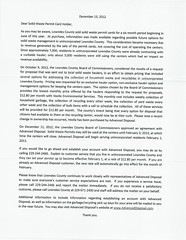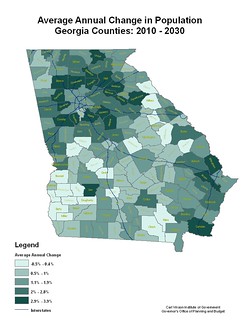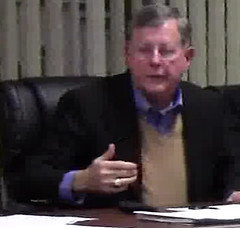 I received the appended unsigned letter from Lowndes County
recently,
which says the
5,000 residents of the unincorporated parts that currently use the
county’s waste disposal sites can sign up with Advanced Disposal
(of New York City) for curbside pickup or…. There is no or. So
look forward to trash dumping long roadsides, in parking lots in
town, and on your property. And neither outgoing County Chairman
Ashley Paulk nor County Manager Joe Pritchard even had the courtesy
to sign the letter.
I received the appended unsigned letter from Lowndes County
recently,
which says the
5,000 residents of the unincorporated parts that currently use the
county’s waste disposal sites can sign up with Advanced Disposal
(of New York City) for curbside pickup or…. There is no or. So
look forward to trash dumping long roadsides, in parking lots in
town, and on your property. And neither outgoing County Chairman
Ashley Paulk nor County Manager Joe Pritchard even had the courtesy
to sign the letter.
After noting that back in June the county changed waste permit
cards from 12 months to 6 months, the letter says:
At purchase, information was made available regarding
possible future options for solid waste management in
unincorporated Lowndes County.
So the county is backing off from claiming card buyers got a
letter spelling out options. I got no such letter with card
purchase.
This consideration became necessary due to revenue
generated by the sale of the permit cards, not covering the cost of
operating the centers.
 And that’s all the accounting we get. Where is the summary of
expenses for the centers compared to revenue? The VDT reported from
the Commissioners’ stealth retreat back in April:
And that’s all the accounting we get. Where is the summary of
expenses for the centers compared to revenue? The VDT reported from
the Commissioners’ stealth retreat back in April:
“In total, the county is currently spending $782,058.34
each year for solid waste disposal, a reduction from $1,176,207.75
in 2007.”
As I pointed out then, “So that’s a rapid reduction in cost to
less than a third of what it used to be, and less than half of what
it was only a year ago.” Later Joe Pritchard said those numbers
didn’t include everything being spent. So what was actually being
spent? We the taxpayers and we the card payers don’t know. After
a long series of meetings to which the public was either not
invited at all or was not invited to provide input, at its last
meeting of the year (exactly as I predicted),
Commissioners approved changes to the solid waste ordinance
eliminating the collection sites and
granted a monopoly to Advanced Disposal Services of
New York City.
Former Chairman Ashley Paulk
recently complained Moody AFB had become “privatized”. Yet at
his last Commission meeting he presided over privatizing the
county’s public service of solid waste collection.
Three new Commissioners were just sworn in yesterday, including
a new chair. The new Commission in the new year is not, so far as I
know, bound by the decisions of any previous Commission. It could
undo the damage the old one just did. Or it could, like the old
one, ignore concerns of
public health, safety, and the environment that
the state requires them to implement, plus concerns of
local waste collection businesses, of local residents
about recycling and
about the lack of any other option than curbside; will the new
Commission continue to kick 5,000 county residents towards curbside
collection or tossing their trash in the your yard?
Unsigned trash letter from Lowndes County:
Continue reading →
 Valdosta resident Forrest H. Williams replied in the VDT today to
my op-ed of 6 January.
His information seems a bit out of date.
For example, he cites
Progress Energy’s Crystal River nuke
as a good example, when it’s been
down since 2009
and is still
producing zero percent power,
both according to the NRC.
Readers of this blog know that
the blog version of my op-ed
already links to sources for everything I said.
I may respond more later, but no doubt there are other people
who want to get involved in this discussion.
And I do thank Forrest H. Williams for airing the sort of disinformation
that is out there, so others can dispel it.
Valdosta resident Forrest H. Williams replied in the VDT today to
my op-ed of 6 January.
His information seems a bit out of date.
For example, he cites
Progress Energy’s Crystal River nuke
as a good example, when it’s been
down since 2009
and is still
producing zero percent power,
both according to the NRC.
Readers of this blog know that
the blog version of my op-ed
already links to sources for everything I said.
I may respond more later, but no doubt there are other people
who want to get involved in this discussion.
And I do thank Forrest H. Williams for airing the sort of disinformation
that is out there, so others can dispel it.












